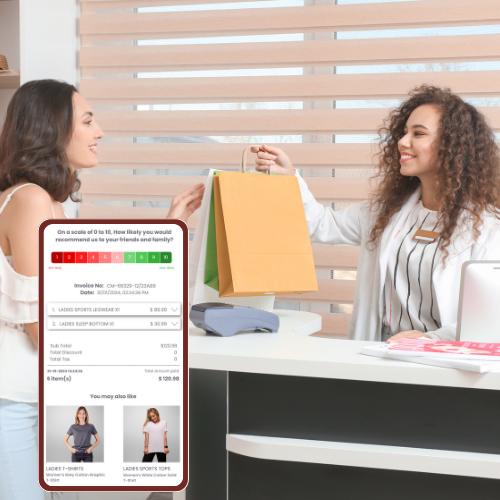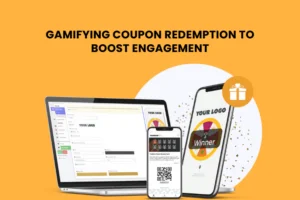eReceipts: Bridging the Gap between Retailers and Customers


eReceipts: Bridging the Gap between Retailers and Customers
What are eReceipts?
eReceipts, or electronic receipts, are the digital counterparts to paper receipts. They are generated at the point of sale (POS) systems and sent directly to customers via email, SMS, or through dedicated apps. They serve as proof of transaction just like paper receipts, but are stored digitally on a device or within a cloud-based system.
Key Features of eReceipts:
Digital Format: They are created and stored in a digital format, which can be accessed from anywhere by the customer, as long as they have access to their email or the app where the eReceipt is saved.
Accessibility: eReceipts can be easily retrieved for returns, warranties, or accounting purposes, unlike paper receipts which can fade, get lost, or become illegible over time.
Contactless & Eco-Friendly: They represent an eco-friendly alternative to paper receipts by reducing the consumption of paper, thus contributing to a company’s sustainability efforts.
Cost-effective: As a retailer, you might be aware that thermal paper rolls cost a fortune. And you need hundreds of them every month! Along with paper, businesses also need to shell out money on ink cartridges for printing.
Multi-lingual: eReceipts can be in different languages as per requirements of the brand and statutes of the geographies operated in.
Instant: eReceipts are delivered instantly within seconds, often before the printed receipt is handed over to the customer.
Reliable: OptCulture’s eReceipts are sent keeping use cases in mind such as regular or exchange receipts, managing internet outages by queuing, and providing best-in-class email delivery.
Advantages of eReceipts Over Traditional Paper Receipts:
Enhanced Customer Experience: eReceipts provide customers with a hassle-free experience. They don’t have to worry about keeping track of paper slips and can easily access their purchase history.
Cost-Effective: Businesses save on the cost of paper and printing. For large retailers, this saving can be substantial over time.
Data Collection: eReceipts facilitate the collection of customer data, such as email addresses and purchasing habits, which can be used for targeted marketing and improved customer service.
Speed and Efficiency: The process of generating and sending an eReceipt is faster than printing a paper receipt, thus speeding up the transaction process.
Security: Digital receipts can reduce the risk of fraud and provide a more secure transaction record that can be encrypted and safely stored.
Marketing Opportunities: eReceipts can be customized to include marketing messages, promotions, and other customer engagement tools, turning every purchase into a potential future interaction.
Latest trends in eReceipts
E-receipts are becoming increasingly popular in the retail industry due to their ability to enhance customer engagement. The latest trends in e-receipts include personalization, convenience, post-purchase engagement, sustainability, and data analytics. Personalization allows retailers to send tailored offers to customers based on their purchase history. Post-purchase engagement enables retailers to provide support and follow-up, gather feedback, and entice customers back into the store with promotions and discounts related to their previous purchases. Sustainability is another trend, as e-receipts are eco-friendly and reduce paper usage. Data analytics is also important, as e-receipts provide valuable data and insights for businesses, allowing them to better understand their customers and make informed decisions about their marketing. E-receipts are expected to become the norm in the future of shopping
Drag & Drop Model
Expanding on the innovative features of OptCulture’s “Lego model” for creating smart eReceipts, we can explore how this model provides a highly customizable and interactive platform for brands to enhance their customer engagement and gather valuable insights.
1. Modular Design with Predefined Widgets
OptCulture’s approach is akin to building with Legos – it offers a range of predefined widgets that brands can use to construct their eReceipts. These widgets are designed to add functionality and engagement opportunities to the eReceipts. Key widgets include:
Loyalty Program Integration: Allows brands to include loyalty program details, points earned, and redemption options directly on the eReceipts.
Credit Notes: Offers the ability to issue and track credit notes, simplifying the return and exchange process for both the customer and the retailer.
Product Recommendations: Based on the customer’s purchase history and preferences, brands can include personalized product recommendations, encouraging further purchases.
Customer Profile Enrichment: Invites customers to update their profiles with additional information, enhancing the brand’s ability to personalize future interactions.
2. Seamless Flow Arrangement
Retailers have the flexibility to arrange these widgets in a way that best suits their customer journey. This customization ensures that the flow of information on the eReceipt is coherent, user-friendly, and aligns with the typical customer’s reading and interaction patterns.
3. Brand Customization
OptCulture understands the importance of brand consistency. The platform allows brands to customize the look and feel of their eReceipts to align with their brand identity. This includes specifying colors, fonts, and overall design themes that resonate with the brand’s guidelines and aesthetics.
4. Targeted Offers and Promotions
Smart eReceipts can be used as a direct marketing tool. Brands can promote offers, discounts, and upcoming events that are specifically targeted to the recipient based on their purchase history and preferences. This targeted approach increases the relevance and effectiveness of promotional content.
5. Real-Time Feedback Integration
One of the most valuable aspects of OptCulture’s eReceipts is the ability to integrate forms or Net Promoter Score (NPS) surveys. This feature enables brands to gather immediate feedback on the customer’s shopping experience, product satisfaction, or overall service quality. The integration of these feedback tools directly into the eReceipts makes it convenient for customers to provide their input, leading to higher response rates and more actionable insights.
6. Interactive and Engaging
By incorporating these features, eReceipts become more than just a transactional record; they turn into interactive and engaging tools for customer communication. They provide customers with valuable information and opportunities to engage further with the brand, enhancing the overall customer experience and satisfaction.
Insights provided by eReceipts into Customer Behavior
eReceipts are a goldmine for insights into customer behavior, thanks to the digital footprint they leave behind. Here’s a detailed look at how they can provide such valuable information:
Direct Data Capture
eReceipts are tied directly to transactions, which means they capture precise details about what customers are buying, when they are buying it, and how often. This data can include:
Item specifics (what was purchased)
Transaction times and dates
Payment methods used
Total spend per transaction
Purchase locations (for multi-location retailers)
Behavioral Tracking
Over time, eReceipt data can be used to track customer behavior trends, such as:
Frequency of purchases
Seasonal purchase patterns
Response to sales promotions
Average transaction value
Cross-category purchasing habits
Linking Purchases to Individuals
By sending eReceipts to a customer’s email or through an app, retailers can link purchase data to specific individuals, rather than anonymous sales data. This enables personalized marketing and the ability to track individual customer lifetime value (CLV).
Segmentation
The rich data from eReceipts allows retailers to segment their customers into meaningful groups based on their purchasing behavior, demographics, and preferences. This segmentation can be used to tailor marketing campaigns, loyalty programs, and even store layouts.
Personalization
With detailed historical purchase data, retailers can personalize the shopping experience for customers by recommending products, customizing marketing messages, and creating personalized offers that increase the likelihood of a sale.
Predictive Analysis
Using historical eReceipt data, retailers can predict future purchasing behavior. This predictive analysis can inform stock levels, new product development, and marketing strategies.
Enhanced Customer Profiles
Combining eReceipt data with other data points such as web browsing behavior, survey responses, and social media interaction creates comprehensive customer profiles. These profiles are invaluable for crafting targeted marketing strategies and improving the overall customer experience.
Integration with Loyalty Programs
eReceipts can be integrated with loyalty programs, providing a seamless way to accrue and redeem points. This integration also offers additional data points on customer preferences and behaviors.
Feedback and Reviews
eReceipts often include links to customer satisfaction surveys or product reviews, offering immediate feedback on the customer experience and product satisfaction.
Operational Improvements
Analysis of eReceipt data can lead to operational improvements, such as identifying peak shopping times for better staff allocation, understanding product pairings for improved merchandising, and optimizing store layouts based on purchase flows.
Incentivized Data Sharing
Customers might be more willing to share additional information if incentivized properly through the eReceipts, like participating in a survey or providing feedback in exchange for a discount on future purchases.
Challenges in Data Use
While eReceipts offers immense benefits, retailers must navigate the challenges of data privacy regulations and ensure that customer data is handled transparently and securely. OptCulture, as a platform, can facilitate this by providing tools that help retailers comply with data protection laws while still leveraging the valuable insights that eReceipt data provides.
In conclusion, the adoption and strategic use of eReceipts, especially through platforms like OptCulture, represent a significant step forward for retailers. It’s an innovation that not only enhances the efficiency of transactions but also opens up new avenues for building lasting customer relationships and driving repeat business. In this digital age, eReceipts are more than a convenience; they are a cornerstone of customer engagement and business growth.




